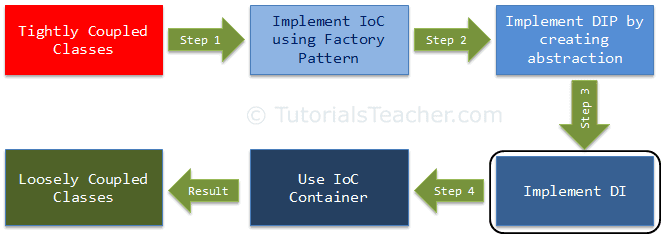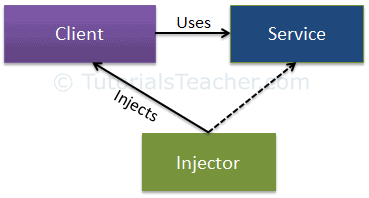Dependency Injection
In the previous chapter, related to DIP, we created and used abstraction to make the classes loosely coupled. Here, we are going to implement Dependency Injection and strategy pattern together to move the dependency object creation completely out of the class. This is our third step in making the classes completely loose coupled.

Dependency Injection (DI) is a design pattern used to implement IoC. It allows the creation of dependent objects outside of a class and provides those objects to a class through different ways. Using DI, we move the creation and binding of the dependent objects outside of the class that depends on them.
The Dependency Injection pattern involves 3 types of classes.
- Client Class: The client class (dependent class) is a class which depends on the service class
- Service Class: The service class (dependency) is a class that provides service to the client class.
- Injector Class: The injector class injects the service class object into the client class.
The following figure illustrates the relationship between these classes:

As you can see, the injector class creates an object of the service class, and injects that object to a client object. In this way, the DI pattern separates the responsibility of creating an object of the service class out of the client class.
Types of Dependency Injection
As you have seen above, the injector class injects the service (dependency) to the client (dependent). The injector class injects dependencies broadly in three ways: through a constructor, through a property, or through a method.
Constructor Injection: In the constructor injection, the injector supplies the service (dependency) through the client class constructor.
Property Injection: In the property injection (aka the Setter Injection), the injector supplies the dependency through a public property of the client class.
Method Injection: In this type of injection, the client class implements an interface which declares the method(s) to supply the dependency and the injector uses this interface to supply the dependency to the client class.
Let's take an example from the previous chapter to maintain the continuity. In the previous section of DIP, we used Factory class inside the CustomerBusinessLogic class to get an object of the CustomerDataAccess object, as shown below.
public interface ICustomerDataAccess
{
string GetCustomerName(int id);
}
public class CustomerDataAccess: ICustomerDataAccess
{
public CustomerDataAccess() {
}
public string GetCustomerName(int id) {
return "Dummy Customer Name";
}
}
public class DataAccessFactory
{
public static ICustomerDataAccess GetCustomerDataAccessObj()
{
return new CustomerDataAccess();
}
}
public class CustomerBusinessLogic
{
ICustomerDataAccess _custDataAccess;
public CustomerBusinessLogic()
{
_custDataAccess = DataAccessFactory.GetCustomerDataAccessObj();
}
public string GetCustomerName(int id)
{
return _custDataAccess.GetCustomerName(id);
}
}
The problem with the above example is that we used DataAccessFactory inside the CustomerBusinessLogic class. So, suppose there is another implementation of ICustomerDataAccess and we want to use that new class inside CustomerBusinessLogic. Then, we need to change the source code of the CustomerBusinessLogic class as well. The Dependency injection pattern solves this problem by injecting dependent objects via a constructor, a property, or an interface.
The following figure illustrates the DI pattern implementation for the above example.

As you see, the CustomerService class becomes the injector class, which sets an object of the service class (CustomerDataAccess) to the client class (CustomerBusinessLogic) either through a constructor, a property, or a method to achieve loose coupling. Let's explore each of these options.
Constructor Injection
As mentioned before, when we provide the dependency through the constructor, this is called a constructor injection.
Consider the following example where we have implemented DI using the constructor.
public class CustomerBusinessLogic
{
ICustomerDataAccess _dataAccess;
public CustomerBusinessLogic(ICustomerDataAccess custDataAccess)
{
_dataAccess = custDataAccess;
}
public CustomerBusinessLogic()
{
_dataAccess = new CustomerDataAccess();
}
public string ProcessCustomerData(int id)
{
return _dataAccess.GetCustomerName(id);
}
}
public interface ICustomerDataAccess
{
string GetCustomerName(int id);
}
public class CustomerDataAccess: ICustomerDataAccess
{
public CustomerDataAccess()
{
}
public string GetCustomerName(int id)
{
//get the customer name from the db in real application
return "Dummy Customer Name";
}
}
In the above example, CustomerBusinessLogic includes the constructor with one parameter of type ICustomerDataAccess. Now, the calling class must inject an object of ICustomerDataAccess.
public class CustomerService
{
CustomerBusinessLogic _customerBL;
public CustomerService()
{
_customerBL = new CustomerBusinessLogic(new CustomerDataAccess());
}
public string GetCustomerName(int id) {
return _customerBL.ProcessCustomerData(id);
}
}
As you can see in the above example, the CustomerService class creates and injects the CustomerDataAccess object into the CustomerBusinessLogic class. Thus, the CustomerBusinessLogic class doesn't need to create an object of CustomerDataAccess using the new keyword or using factory class. The calling class (CustomerService) creates and sets the appropriate DataAccess class to the CustomerBusinessLogic class. In this way, the CustomerBusinessLogic and CustomerDataAccess classes become "more" loosely coupled classes.
Property Injection
In the property injection, the dependency is provided through a public property. Consider the following example.
public class CustomerBusinessLogic
{
public CustomerBusinessLogic()
{
}
public string GetCustomerName(int id)
{
return DataAccess.GetCustomerName(id);
}
public ICustomerDataAccess DataAccess { get; set; }
}
public class CustomerService
{
CustomerBusinessLogic _customerBL;
public CustomerService()
{
_customerBL = new CustomerBusinessLogic();
_customerBL.DataAccess = new CustomerDataAccess();
}
public string GetCustomerName(int id) {
return _customerBL.GetCustomerName(id);
}
}
As you can see above, the CustomerBusinessLogic class includes the public property named DataAccess, where you can set an instance of a class that implements ICustomerDataAccess. So, CustomerService class creates and sets CustomerDataAccess class using this public property.
Method Injection
In the method injection, dependencies are provided through methods. This method can be a class method or an interface method.
The following example demonstrates the method injection using an interface based method.
interface IDataAccessDependency
{
void SetDependency(ICustomerDataAccess customerDataAccess);
}
public class CustomerBusinessLogic : IDataAccessDependency
{
ICustomerDataAccess _dataAccess;
public CustomerBusinessLogic()
{
}
public string GetCustomerName(int id)
{
return _dataAccess.GetCustomerName(id);
}
public void SetDependency(ICustomerDataAccess customerDataAccess)
{
_dataAccess = customerDataAccess;
}
}
public class CustomerService
{
CustomerBusinessLogic _customerBL;
public CustomerService()
{
_customerBL = new CustomerBusinessLogic();
((IDataAccessDependency)_customerBL).SetDependency(new CustomerDataAccess());
}
public string GetCustomerName(int id) {
return _customerBL.GetCustomerName(id);
}
}
No comments:
Post a Comment